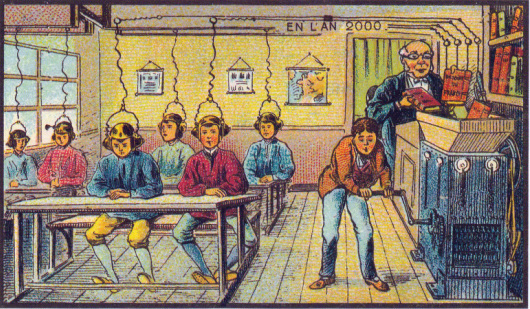
David Pearce, a Digital Learning Manager at Oxford University Press, looks at the issues surrounding the implementation of digital technology in the classroom. David will be presenting on this topic at IATEFL 2015 on Sunday 12th April.
A charming image created in 1910, by the French artist Villemard, attempted to depict what a classroom would look like in the year 2000. To the right of the image stands a hand-cranked machine with a feeding chute at the top. A boy stands over the handle, cranking it round as the bewhiskered school master feeds books into the chute. Wires run from the machine to the ceiling of the classroom, leading eventually to headsets worn by the attentive pupils. Knowledge, ground out of the pages of the books and metamorphosed into some kind of energy, is transferred directly to their brains.
The scene says as much about the theory of knowledge at the time as it does about the imagined labour-saving transformations of technology. We are now less inclined to believe that learning is about the passive reception of knowledge. These days we think of knowledge as something actively constructed by the learner, and of knowledge as being only one part of learning, with skills like collaboration, communication and critical thinking forming as big a part, if not bigger, of what students need to learn. As for the technology portrayed, part of the charm of the image lies in how naïve the machinery seems to us, reflecting a time when the electrification of life was starting to become commonplace, it’s possibilities apparently boundless.
And yet Villemard was surprisingly accurate. A lot of the features of the 21st century classroom are as he depicted them. The classroom itself remains, there are still children seated at desks, and there is still a teacher presiding over events. And of course there are still lots and lots of books. We may not be grinding them into energy to beam straight into our students’ heads, but we are grinding their contents into data to go online, or into e-books, or onto interactive whiteboards. And perhaps we still hope that technology will somehow make the job of learning effortless – this is what the picture seems to say to me.
The centrepiece, however, is the machinery itself: for the time it is modern, bizarre, and a little bit fantastic. And isn’t this what a lot of us feel about the technology we’re expected to use with our own students? Although the technology depicted seems strange to us, is it any more bizarre than the actual technology we’ve ended up with? Just as Villemard was an artist working when electricity had become an everyday reality with boundless potential, we live at a time when the same thing is happening with digital technology. Making sense of its potential is not always straightforward.
My workshop – “Digital or Analogue: Making Choices About Technology in Lesson Planning” – is intended for those educators who want to bring modern technology into their classrooms, but who may be unsure about how or when to use it. There are lots of reasons why using technology might be difficult: a lack of expertise or confidence, inadequate equipment, poor internet connectivity – and sometimes simply not knowing where to start. In the workshop we will explore together how simple principles can be applied in our everyday teaching, and how small changes to our practice can build technology into what we do. Learning with technology may not be as effortless as Villemard suggested it might be, but teaching with it needn’t be a grind.


Reblogged this on zandyvila.